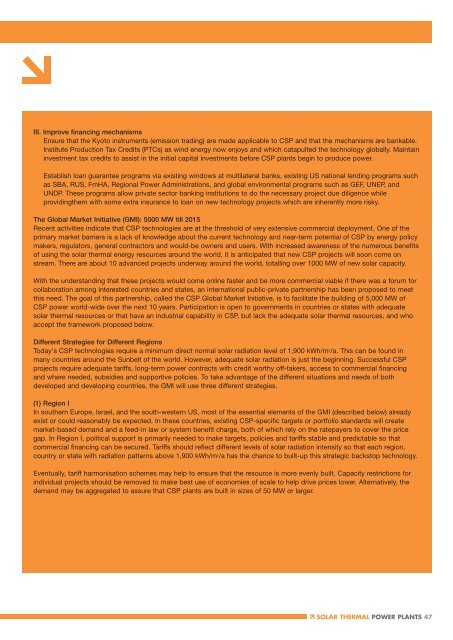solar thermal power - Greenpeace
solar thermal power - Greenpeace
solar thermal power - Greenpeace
Create successful ePaper yourself
Turn your PDF publications into a flip-book with our unique Google optimized e-Paper software.
III. Improve financing mechanisms<br />
Ensure that the Kyoto instruments (emission trading) are made applicable to CSP and that the mechanisms are bankable.<br />
Institute Production Tax Credits (PTCs) as wind energy now enjoys and which catapulted the technology globally. Maintain<br />
investment tax credits to assist in the initial capital investments before CSP plants begin to produce <strong>power</strong>.<br />
Establish loan guarantee programs via existing windows at multilateral banks, existing US national lending programs such<br />
as SBA, RUS, FmHA, Regional Power Administrations, and global environmental programs such as GEF, UNEP, and<br />
UNDP. These programs allow private sector banking institutions to do the necessary project due diligence while<br />
providingthem with some extra insurance to loan on new technology projects which are inherently more risky.<br />
The Global Market Initiative (GMI): 5000 MW till 2015<br />
Recent activities indicate that CSP technologies are at the threshold of very extensive commercial deployment. One of the<br />
primary market barriers is a lack of knowledge about the current technology and near-term potential of CSP by energy policy<br />
makers, regulators, general contractors and would-be owners and users. With increased awareness of the numerous benefits<br />
of using the <strong>solar</strong> <strong>thermal</strong> energy resources around the world, it is anticipated that new CSP projects will soon come on<br />
stream. There are about 10 advanced projects underway around the world, totalling over 1000 MW of new <strong>solar</strong> capacity.<br />
With the understanding that these projects would come online faster and be more commercial viable if there was a forum for<br />
collaboration among interested countries and states, an international public-private partnership has been proposed to meet<br />
this need. The goal of this partnership, called the CSP Global Market Initiative, is to facilitate the building of 5,000 MW of<br />
CSP <strong>power</strong> world-wide over the next 10 years. Participation is open to governments in countries or states with adequate<br />
<strong>solar</strong> <strong>thermal</strong> resources or that have an industrial capability in CSP, but lack the adequate <strong>solar</strong> <strong>thermal</strong> resources, and who<br />
accept the framework proposed below.<br />
Different Strategies for Different Regions<br />
Today's CSP technologies require a minimum direct normal <strong>solar</strong> radiation level of 1,900 kWh/m 2 /a. This can be found in<br />
many countries around the Sunbelt of the world. However, adequate <strong>solar</strong> radiation is just the beginning. Successful CSP<br />
projects require adequate tariffs, long-term <strong>power</strong> contracts with credit worthy off-takers, access to commercial financing<br />
and where needed, subsidies and supportive policies. To take advantage of the different situations and needs of both<br />
developed and developing countries, the GMI will use three different strategies.<br />
(1) Region I<br />
In southern Europe, Israel, and the south-western US, most of the essential elements of the GMI (described below) already<br />
exist or could reasonably be expected. In these countries, existing CSP-specific targets or portfolio standards will create<br />
market-based demand and a feed-in law or system benefit charge, both of which rely on the ratepayers to cover the price<br />
gap. In Region I, political support is primarily needed to make targets, policies and tariffs stable and predictable so that<br />
commercial financing can be secured. Tariffs should reflect different levels of <strong>solar</strong> radiation intensity so that each region,<br />
country or state with radiation patterns above 1,900 kWh/m 2 /a has the chance to built-up this strategic backstop technology.<br />
Eventually, tariff harmonisation schemes may help to ensure that the resource is more evenly built. Capacity restrictions for<br />
individual projects should be removed to make best use of economies of scale to help drive prices lower. Alternatively, the<br />
demand may be aggregated to assure that CSP plants are built in sizes of 50 MW or larger.<br />
SOLAR THERMAL POWER PLANTS 47

















